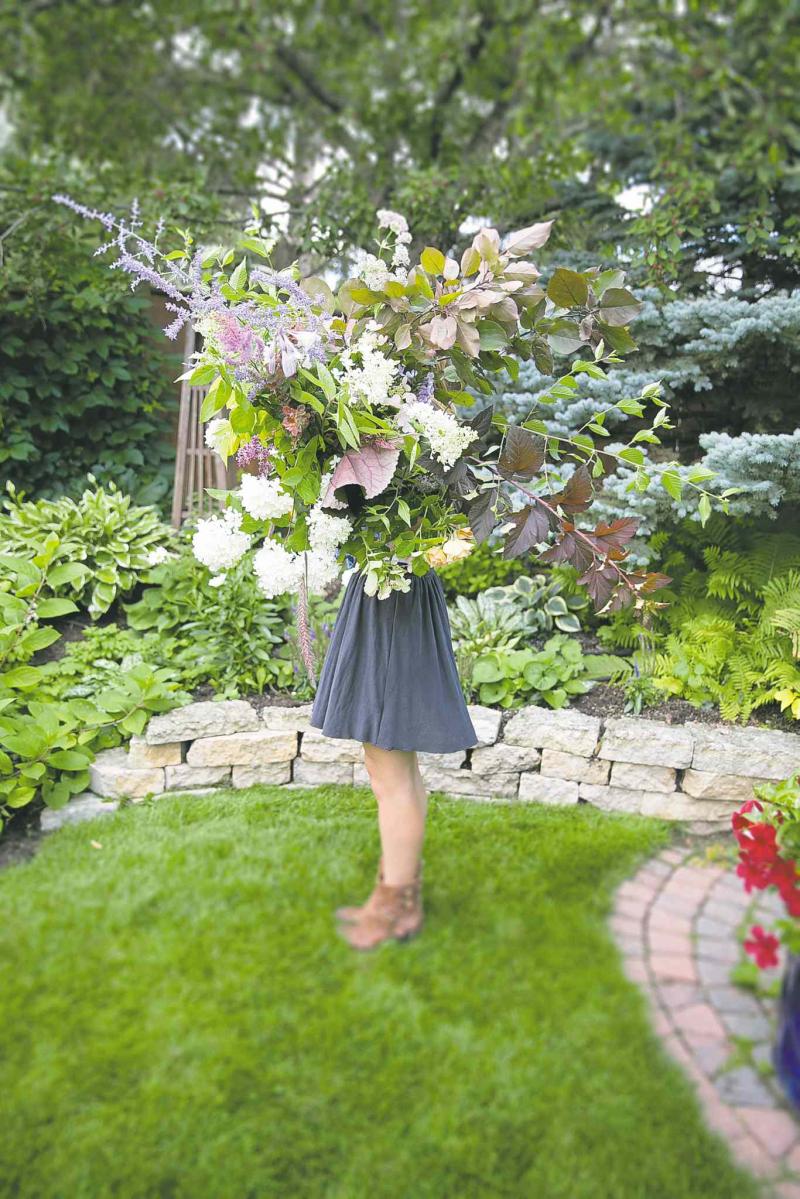
Photography is one way to capture the essence of your garden. Creating a bouquet with foraged plants is another.
In a contemporary take on the art of floral design, garden bouquets shouldn't be limited to flowers, say floral designers Heather Page and Kyla Ferguson, co-workers at Academy Florists. Close friends who regularly make a habit of foraging in their own backyards, and admittedly in back lanes or wherever else they spot the perfect plant material, Page and Ferguson take their cue from nature.
Using a mix of plant material that includes tree and shrub branches dripping with clusters of berries, apples, sometimes even strawberries and raspberries, their perspective is that nearly perfect is perfect enough. Chewed bits of leaves and blooms that are full-blown or past their prime? Not a problem.
When creating a foraged bouquet, Page and Ferguson adhere to the concept of Wabi-sabi, an aesthetic steeped in Japanese tradition that finds beauty in imperfection and the life cycle of plants, indeed, even the effects of rain and wind.
That produced a sigh of relief on my part when they visited my garden for a foraging expedition on a sunny Sunday morning in early August. I took care to weed and deadhead before they arrived and fretted a bit over the damage caused by rose sawfly which had decimated the lower leaves on some of my roses.
Although the flowering period for peonies and delphiniums had already passed and my daisies were nearly done, I was thankful that the hydrangeas were all in bloom. After surveying my containers, I felt reasonably satisfied with the choice of annual plants that might interest them.
After a quick walk through the garden, it soon became clear that I was clueless as to the plants that would appeal most to them for creating a garden bouquet.
They arrived with a small waist-high work table, basic tools, plain white vases in assorted shapes, and aluminum buckets filled with tree branches dripping with chokecherries and green apples, foraged from their own gardens.
A gardener's tools always tell an interesting story. Laid out neatly in preparation, Page's vintage hand tools have a precise appearance, their blades spotless and sharp for making clean cuts. Each of her tools has a specific use. The heavier secateurs are for thick branches, the lighter ones for thinner stems. Bonsai snips are used for finishing work. A pair of sharp scissors is needed for cutting string or ribbon. A small paring knife is her favoured tool most of the time, says Page.
Sanitation is critical. Once even a trace of bacteria on tools enters a cut stem, says Page, its vase life is shortened. Page cleans her tools with a solution of bleach and water. She also oils them regularly with Pam Cooking Spray. Olive oil works, too, says Ferguson.
What are the design elements and techniques that you need to consider when selecting plant material and artfully arranging it into a bouquet? Page says that some of the best designers whose work she enjoys are self-taught, inspired by their passion and creativity. The key to bringing the garden into your home and life, she says, is to avoid an arranged look.
"So long as you are taking steps to properly handle and care for the cut stems of flowers and foliage," says Page, "you can do no wrong." Ferguson adds that some might argue that it is important to stay within the boundaries of specific design principles, however, if you are creating a bouquet for yourself which is aesthetically pleasing to you, that's all that matters.
There's little wiggle room, though, when it comes to good mechanics. Both stress the importance of removing any debris from stems as well as foliage from the portion of the stem that will be in water.
Page does not use floral preservative, aspirin or ginger ale when she is creating a backyard bouquet. Her preference is for clean, fresh water which she changes regularly. Floral foam, a petroleum-based product, is falling out of favour because of its inability to decompose. For foraged bouquets, Ferguson prefers to use a strip of chicken wire rather than floral foam. She fashions the wire into an egg-shape then places and fits it inside the middle to upper half of a vase. It creates a grid, says Ferguson, for holding stems in place.
Page likes to use vintage floral frogs, a more expensive option, but one that is adept at holding even the trickiest types of stems. Whatever your choice, it must be clean and free of bacteria.
Page's opening comments when she surveyed my garden was that she and Ferguson would try not to take everything. Well, anything for an article, right? I needn't have worried. After each had gathered an armful of flowers and foliage, placing it all into waiting buckets filled with fresh water, there was very little evidence that anything was missing in the flower beds and containers.
Page selected stems from a Siberian elm for the small green leaves with serrated edges together with the green bronze foliage of rosybloom crabapple and greenish purple leaves of an aging Thunderchild, both dripping with clusters of small fruit with just a hint of ripening fall colour. Branches from Amber Jubilee ninebark with reddish-brown foliage and glints of gold colour as well as small, dense wine-coloured flower clusters were combined with the purplish-maroon branches of Diablo ninebark.
Barberry with its delicate, rounded leaves, thick thorny stems and uniquely variegated burgundy colour paired strikingly with stems of silvery blue Russian sage and a few, oversized, deep purple leaves of Othello ligularia. Flowering stems included Echinacea and hydrangea, mostly Quick Fire, Bombshell, and Little Lime, as well as a pale lilac-blue phlox and Bloomerang lilac enjoying a second flush of bloom.
The soft plumes of astilbe together with the usually under-appreciated hosta blooms were added although there was excitement at discovering generous-sized clumps of small, delicate flowered astrantia, a plant that costs florists a small fortune to import.
Even the spent, faded flowerheads of allium were included. Page says that once plants past their prime are tucked into a bouquet, you are able to utilize the parts of the plant that still look lovely.
A favourite choice, though, in spite of rose sawfly damage on the leaves, was Bill Reid rose for its soft yellow petals, gold centre and peach-coloured edges. Page simply snipped off all of the munched leaves.
As for annuals, only the brightly chartreuse foliage of Sun King aralia, feathery plumes of Purple Fountain grass and cascading succulent stems of pale green Mezoo were of any real interest. After all, the very notion of a foraged bouquet is one that has an untamed, planned-by-nature feel to it.
Not all of the selected stems made it into the finished bouquet. The creative process is one of trial and error. While Ferguson and Page insist that beauty is in the eyes of the beholder, both could be observed carefully selecting and combining this and that stem, removing some, and always stepping back to assess how the arrangement was coming together.
In formal flower design, focal points together with secondary points of interest or accents as well as elements selected for contrast are general rules of thumb. In the foraged bouquet, the seemingly random assortment of textures and shapes should also attain visual movement and repetition.
Container gardeners are more than familiar with the de rigueur thriller, filler, spiller concept. In the foraged bouquets that were created by Page and Ferguson, though, I was intrigued by the horizontal or radiating lines from the center of the bouquet.
"I like a lot of reach on an arrangement," says Page, "so that the viewer's eye travels to the blossoms, foliage, apples and berries at the perimeters of the bouquet." Rather than a starkly upright or somewhat arching design, Page and Ferguson prefer to emulate the natural form of plants in the garden and the enticing drape of fruit and berries.
Proportion, too, is important. Ferguson suggests using branches on a tree or shrub that have a longer, angular shape to balance the other elements in the design.
How long will your foraged bouquet last? Indoors, with the proper care, it can last up to 5 days or more. If your display is for an outdoor garden party, expect wind, heat, and direct sunlight to be factors. Be sure to weight down the vase with stones or marbles.
colleenizacharias@gmail.com
Notice:
Tomorrow at the Assiniboine Park Conservatory, from 1 p.m. to 5 p.m., the Herb Society of Manitoba will host its annual HerbFest. Enjoy herb-infused treats, vendor displays, and activities adjacent to the outdoor herb garden.



